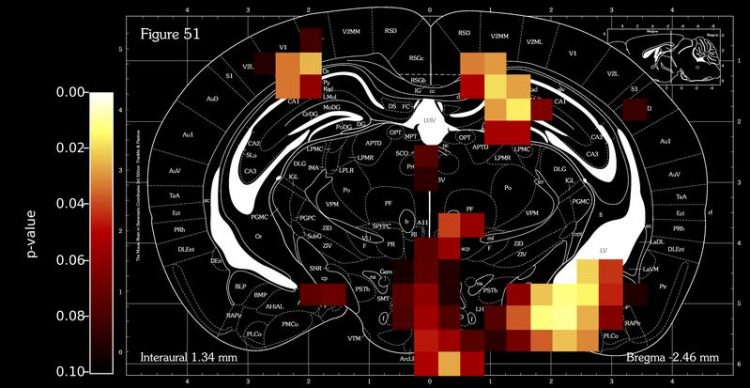Fat tissue in energy saving mode

Cross-section through the mouse brain: Regions that are activated by the AgRP neurons are highlighted (yellow: weakly active, brown: highly active). MPI for Metabolism Research
What happens when we get hungry? How does the brain control energy expenditure? To find answers to these questions a research team led by Jens Brüning, director of the Max Planck Institute for Metabolism Research, analyzed the function of a specific class of nerve cells in the brain, called AgRP neurons.
“These nerve cells are located in the hypothalamus, which can be seen as the brain command center controlling appetite”, explains Sophie Steculorum, one of the authors of the study and associate of Brüning. “It has already been known for a few years that these cells control feeding behavior in hunger states”.
In the recent study, researchers demonstrated that in mice AgRP neurons use an additional mechanism to regulate the sugar metabolism in the body. “These AgRP neurons tell the body to use less blood sugar when the mouse is hungry and cannot find food”, says Johan Ruud, co-author of the study.
Reprogramming the brown fat tissue
The cologne scientists could show that the AgRP neurons are connected with the brown adipose tissue, also called brown fat. “When the neurons are activated, the cells in this brown fat tissue are reprogrammed – they produce a different set of proteins, for example high levels of myostatin”, explains Ruud.
The protein myostatin is usually found in muscle cells and slows down muscle growth. Now the scientists could show for the first time that myostatin directly controls the sensitivity of the brown fat to insulin, which dictates how the body utilizes blood sugar.
AgRP neurons in human
AgRP neurons, myostatin and insulin are not only found in mice, but also in humans. Obesity and type-2-diabetes are likely associated with chronic activation of AgRP- neurons, at least in mice. The mechanism could explain why AgRP neurons are connected with those diseases. “Next we want to find out whether the cells also control the sensitivity of brown fat to insulin in humans”, explains Steculorum.
Media Contact
More Information:
http://www.sf.mpg.deAll latest news from the category: Life Sciences and Chemistry
Articles and reports from the Life Sciences and chemistry area deal with applied and basic research into modern biology, chemistry and human medicine.
Valuable information can be found on a range of life sciences fields including bacteriology, biochemistry, bionics, bioinformatics, biophysics, biotechnology, genetics, geobotany, human biology, marine biology, microbiology, molecular biology, cellular biology, zoology, bioinorganic chemistry, microchemistry and environmental chemistry.
Newest articles

First-of-its-kind study uses remote sensing to monitor plastic debris in rivers and lakes
Remote sensing creates a cost-effective solution to monitoring plastic pollution. A first-of-its-kind study from researchers at the University of Minnesota Twin Cities shows how remote sensing can help monitor and…

Laser-based artificial neuron mimics nerve cell functions at lightning speed
With a processing speed a billion times faster than nature, chip-based laser neuron could help advance AI tasks such as pattern recognition and sequence prediction. Researchers have developed a laser-based…

Optimising the processing of plastic waste
Just one look in the yellow bin reveals a colourful jumble of different types of plastic. However, the purer and more uniform plastic waste is, the easier it is to…



